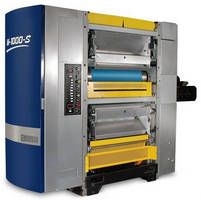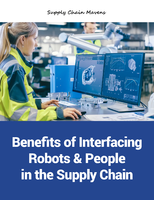B&L Remans Harris M-1000 from Shafted to Shaftless Press, Cuts Make-Ready Time in Half

Using Siemens servo controls package and mechatronics service, retrofitter transforms printing press for Ovid Bell
Located in Effingham, Ill., B&L Machine & Design specializes in the remanufacturing of various printing presses and ancillary equipment. Its particular expertise is on the Harris M-1000 and M-110 series presses, as well as splicers, infeeds, chillers and folders. By redesigning all the electrical and mechanical components and subsystems, B&L exceeds customer expectations for the increased set-up, changeover and print speeds demanded by today's publishing industry, while saving substantial capital for commercial printing companies.
Ovid Bell Press in Fulton, Mo. specializes in print runs from 5,000 to 125,000 copies and works for a variety of multi-color magazine and journal publishers. Recently, B&L needed to help this customer perform shorter-run production work as well as meet the critical make-ready time reductions. Make-ready, in this case, is defined as the period from deceleration after a print run through the time required to remove components as well as the set-up configuration from the previous job. It also covers the installation of new components and set-up on the next job and, finally, the time needed to accelerate the press back up to adequate speed and production of the new forms, all with comparable print quality. A productive press under these short-run conditions must have faster changeover times than traditional presses in the commercial sector, where the runs are considerably longer.
According to Jim Strange, manufacturing manager and electrical engineering supervisor at B&L, "I would say that the shaftless printing implementation on this particular Harris M-1000 press was the biggest part of our challenge. We had determined a shaftless design was the best solution to provide the flexibility of options needed for our core base of printing equipment, in order to compete in this new short run arena." Strange explained that the press infeed system was converted to a belt drive, eliminating the need for gear trains and oil baths. All the web tension controls were moved to the servo motion processor, thereby further reducing component count.
B&L redesigned the entire gear train, from a standard line shafted unit, to accept dual motor servo control. By doing this, over 60 components were eliminated by a circumferential register control for all new motor mounts, plate and blanket gearing and servo positioning. The engineers, both mechanical and electrical, at B&L also produced an accurate and reliable plate loading system that enabled plate changes in a fraction of the time required on shafted presses, while leaving the web stationary on the press. This was made possible by the accuracy and flexibility of the servo drive system, according to Strange.
Finally, the folder section of the press was rotated, creating a smaller footprint and improving the folder use, which enabled this customer to install another similar press that can feed either the existing folder or new one. This solution created a more flexible pressroom for better response to market conditions and job flow.
To help with this conversion, B&L contacted three of the largest suppliers of servo control systems for its industry. Each candidate was supplied a press layout, specifics on each piece of required equipment and print quality goals needed to achieve a successful project. A 30-day window was allotted for proposals. When all the proposals had been received and reviewed, the project was awarded to Siemens. Larry Hines, president and owner of B&L, attributed this decision to the vendor's design assistance, technical competence, service support and current installed base on similar equipment.
The Siemens solution included a Simotion D445 motion controller, Sinamics S120 drives and 1PH7 servo motors. B&L utilized the Simotion Shaftless Standard, a pre-configured application that implements the basic operations for a coordinated motion system and includes rudimentary HMI screens. This software is provided at no charge and saves a great number system engineering hours.
An all-servo design enabled B&L to eliminate drive lines and gave this remanufacturer considerable flexibility in the reconfiguration of existing equipment. Rod Davidson, senior mechanical engineer for B&L, said, "The servo drives enabled us to redesign the entire infeed, and we integrated an absolute encoder to control web tension for smoother operation. Furthermore, the servo drives in the print units let us remove a large number of existing components. Being able to access all the motor position information and scale it to our needs made it easy to build intelligent HMI screens for setting up the phasing, plate positioning and register control." Finally, he noted the servo drive in the chill unit facilitated further reduction of component count and simplified belt drive configurations. All the mechanical and electrical reconfiguration was accomplished without the need for costly clutch components, according to Davidson.
"The make-ready time was the area most affected by the servo system. It was cut by at least 50 percent," said Jim Strange. "The servo system provides the accuracy we required to make the overall process work with dependable, repeatable results." He also commented that the servo-controlled circumferential register control increased the press accuracy and provided savable print more quickly. Scrap reduction savings have been in the 20 percent range, as well as a corresponding time savings achieved by a faster time-to-good print output.
Overall install time on the press was cut by over 25 percent, due to less drive line construction required, while manufacturing time was reduced by 20 percent, thereby benefiting B&L and its customer alike.
MECHATRONICS IDENTIFIES PROBLEM DURING COMMISSIONING, HELPING CUSTOMER COMPLETE PROJECT
During the commissioning process on this Ovid Bell printing press rebuild at B&L, a mechatronics analysis and optimization protocol was conducted by Razvan Panaitescu, engineering manager for mechatronics standards and regulations at Siemens, working in tandem with his Siemens counterparts in application engineering and installation. Mechatronics is the integration of electronics and mechanical engineering, relating to the performance or the design of equipment and machinery. Razvan Panaitescu is a leading authority in this discipline for Siemens.
A problem had surfaced during the test runs on the rebuilt shaftless Harris M-1000 offset press, involving an out of tolerance registration issue. The registration points were visibly oscillating, and the cause was initially thought to lie with the controllers or drives installed as part of the new Siemens product suite onboard.
However, Panaitescu and his team determined the problem resulted from gaps between both the plate and blanket cylinders on the press. When the controllers were finely tuned in a damping optimal setting of higher integrator times and lower proportional gains, the print quality was significantly improved and the registration problems seemed to subside. Not convinced the goal had yet been met, Panaitescu did further vibration testing. A thorough vibration and modal analysis was conducted, using the sophisticated instruments of the Siemens Mechatronics department. The problem was still evident, though to a lesser degree. As he explained, "A resonant frequency remained detectable and that led us to believe there were further mechanical problems in the gear train on two print units, as both continued to reflect unacceptable vibration conditions." The suggestion was made to check the mechanical accuracy of the gear train and possibly the gear teeth dimensions.
As Panaitescu mused, "Just as a doctor uses the stethoscope on patients, we listen to the drives and press cylinders. From our analysis, we determined the mesh frequency was indicating a sprocket/gear problem."
In the end, it was determined by B&L and its supplier that an off-normal angle bore on a gear and sprocket assembly was indeed the root cause of the registration problems. Replacements were installed and the press is running well, the result of the mechatronics applied here.
For more information on this story, please contact:
Siemens Industry, Inc.
Drive Technologies - Motion Control (Production Machines)
390 Kent Avenue
Elk Grove Village, IL 60007
Phone: 847-640-1595
Fax: 847-437-0784
Web: http://www.usa.siemens.com/motioncontrol
Email: SiemensMTBUMarCom.sea@siemens.com
Attention: John Meyer, Manager, Marketing Communications
or
B&L Machine & Design
One Legend Park
North Route 45
Effingham, IL 62401
Phone: 217-342-3918
Fax: 217-342-2081
Web: www.blmachinedesign.com
Email: lhines@blmachinedesign.com
Attention: Larry Hines, President/Owner




